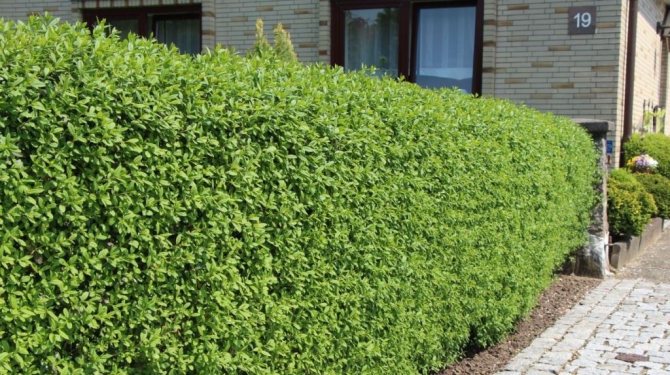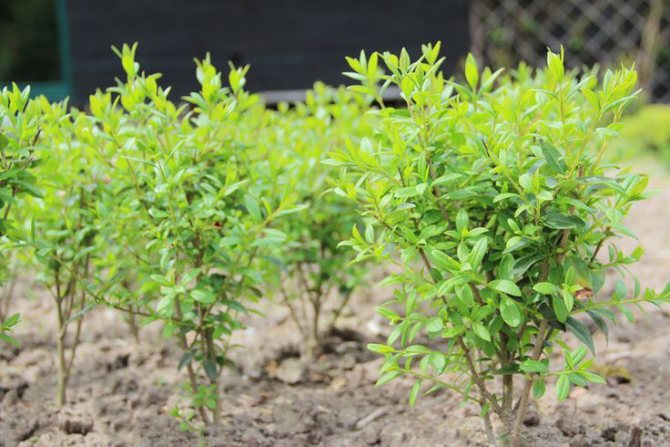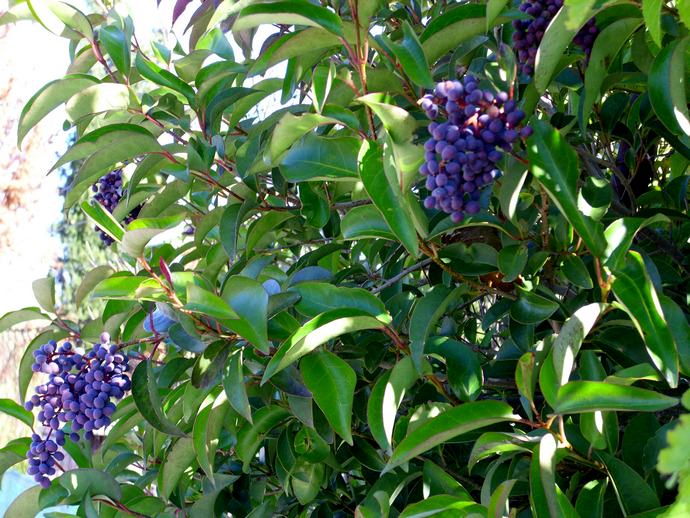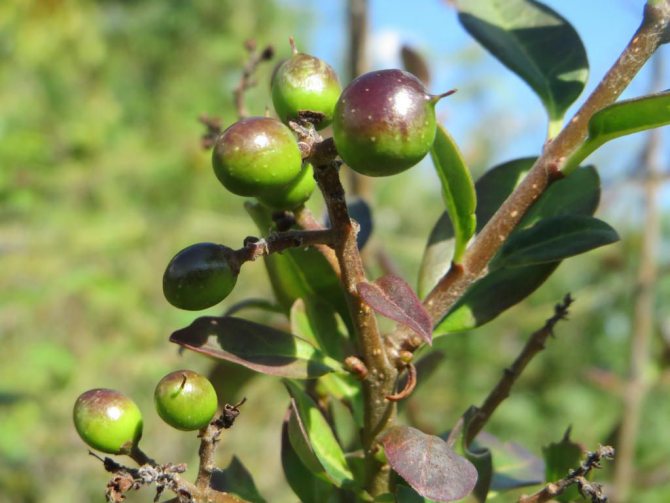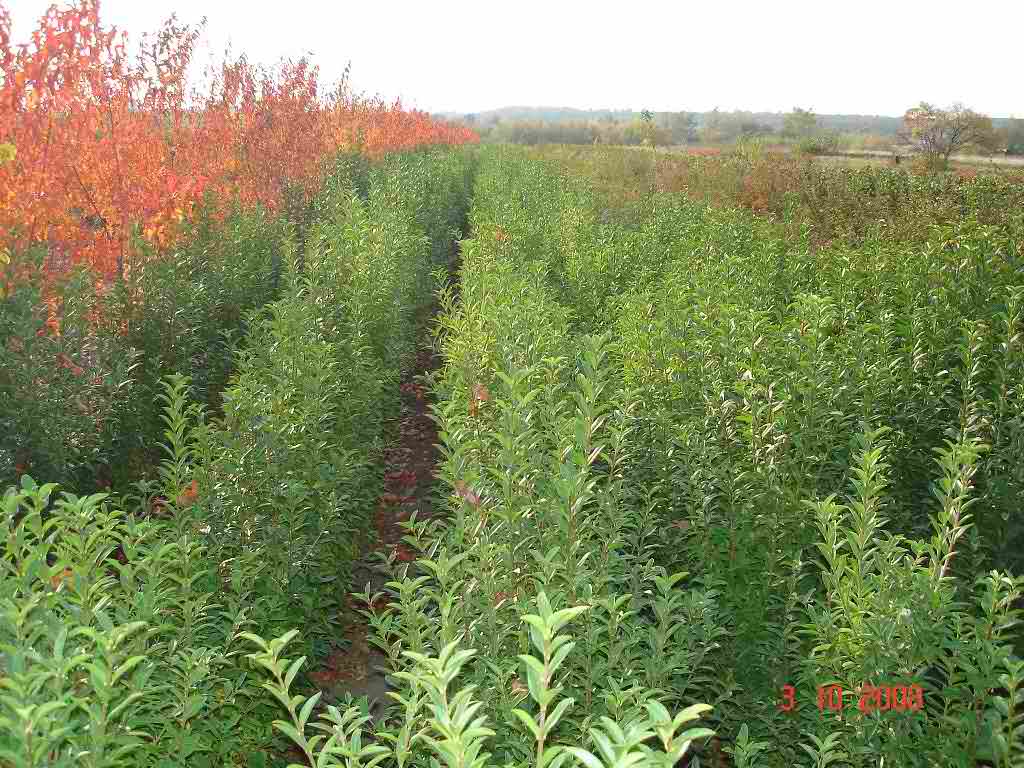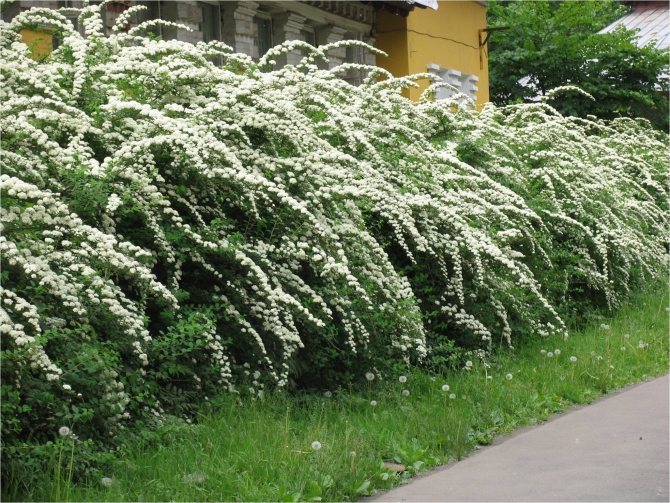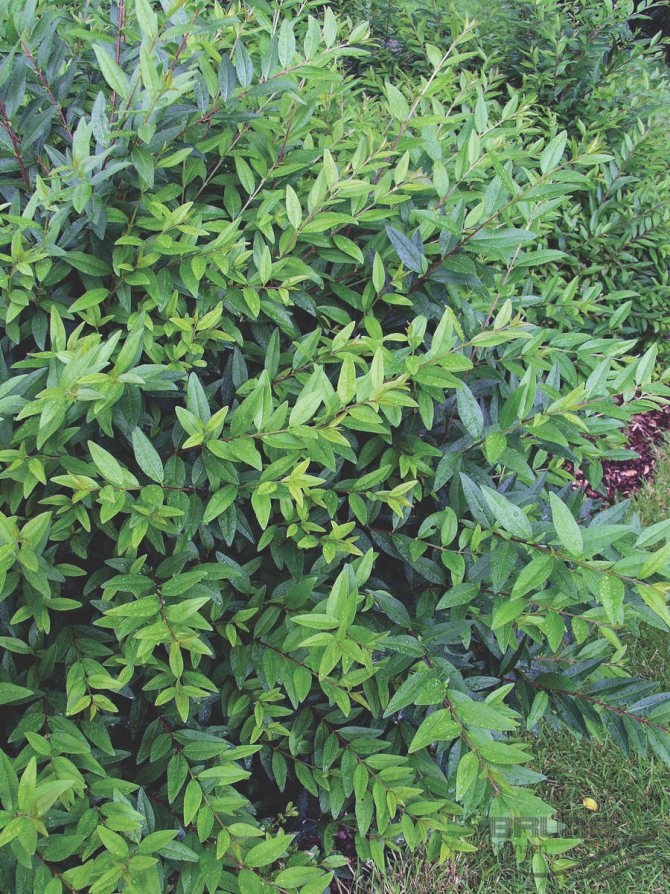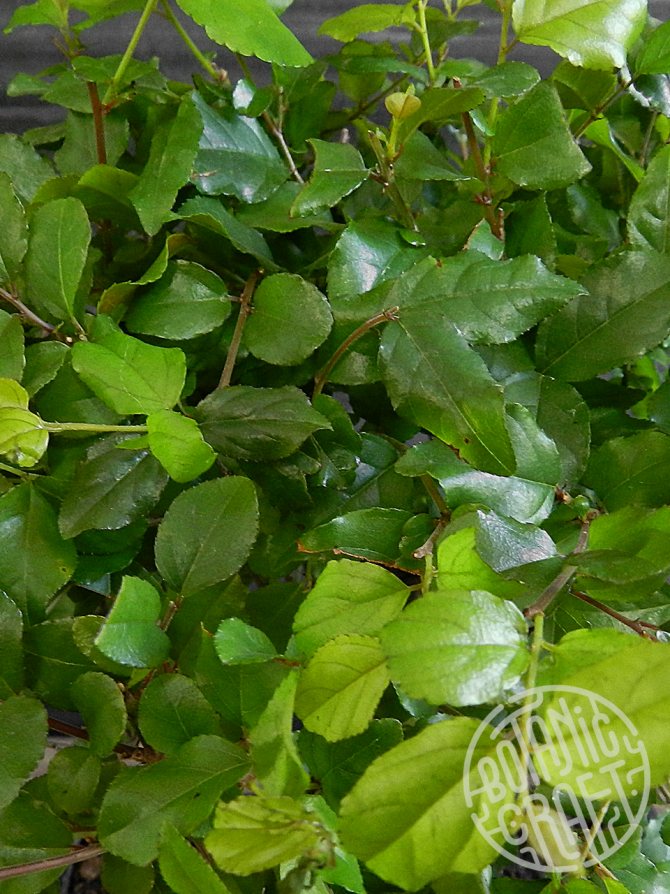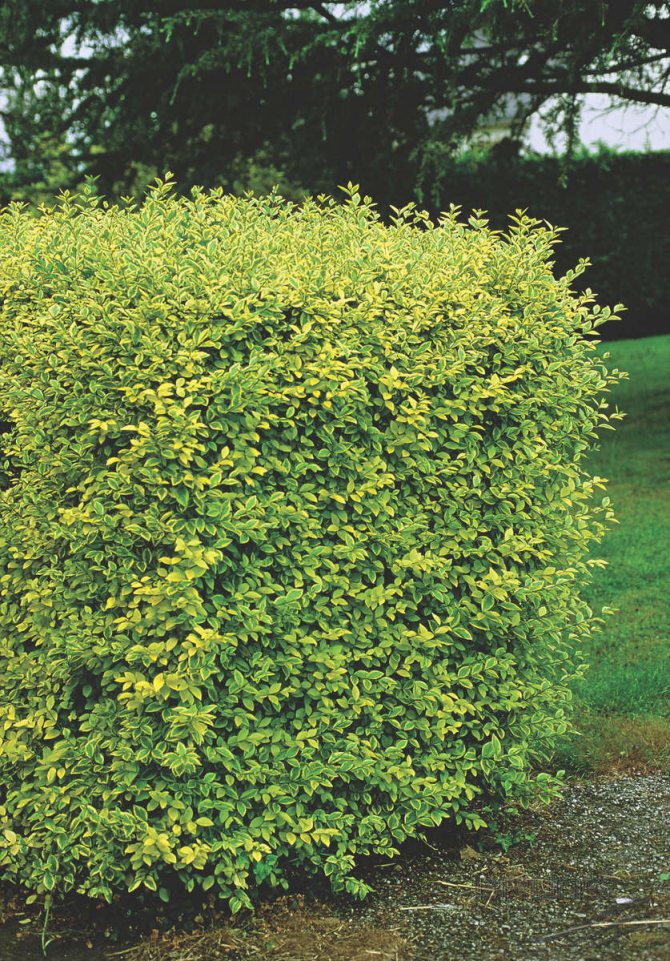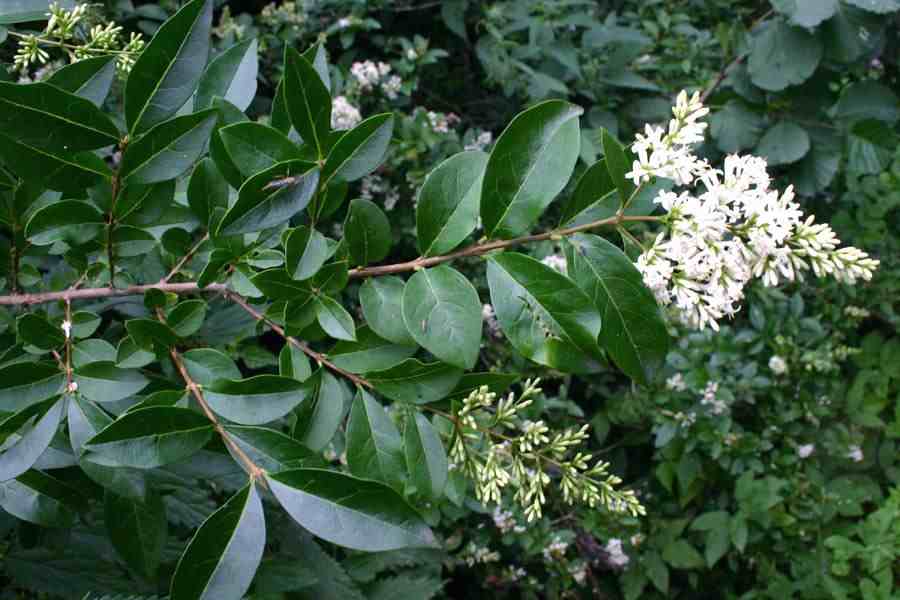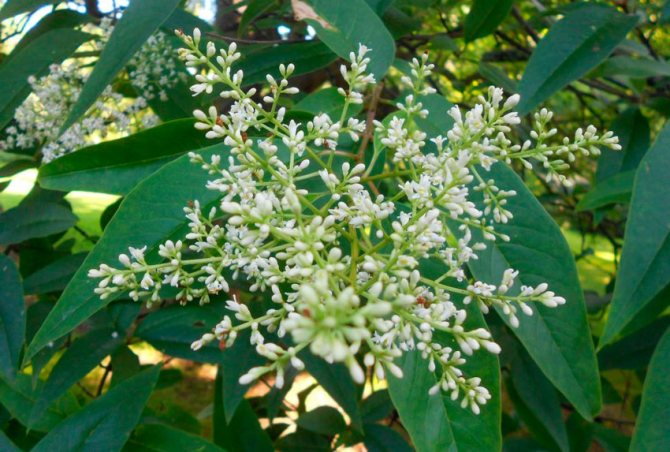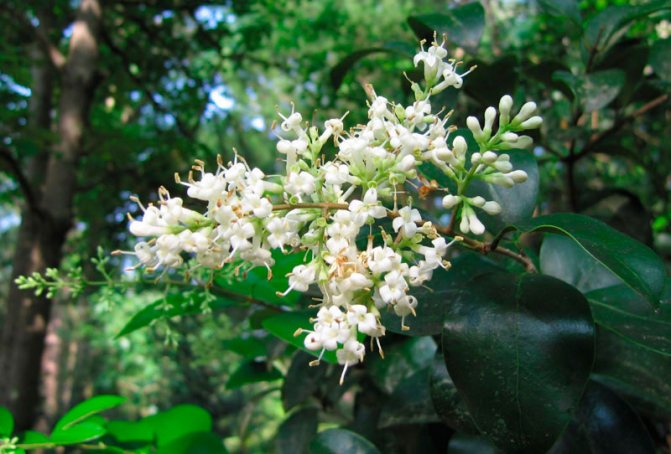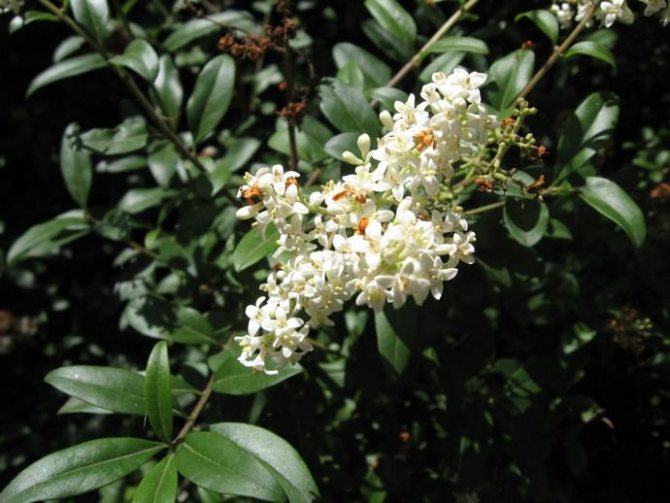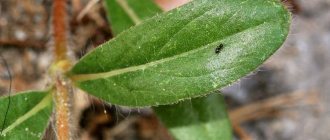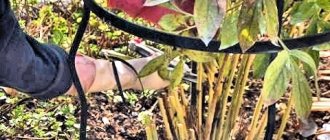The genus privet (Ligustrum) is represented by deciduous, evergreen and semi-evergreen shrubs, as well as small trees, and it is directly related to the olive family. This genus unites more than 50 species of various plants. In natural conditions, they can be found in Asia, North Africa, Europe, and also in Australia. A large number of different types of privet can be found in nature in Japan, Taiwan, China and the Himalayas. The name privet comes from the Latin word "ligare", which translates as "to bind". The fact is that the bark of a plant has astringent properties. Privet shrub is very similar to lilac, as it is its close relative. The foliage and bark of these two plants are very similar, however, the lilac is somewhat larger than privet and its flowering is more splendid and showy. If this shrub is not taken care of, then it will acquire an extremely unattractive and sloppy appearance. However, if you cut it, then it will instantly transform, in addition, it can be given various attractive shapes.
General description of the shrub
The plant in the form of a shrub is up to one meter wide, and can grow up to two meters in length. The trees reach a height of six meters. On the branches of the plant, leathery, elongated-ovate, whole-edged leaves are located oppositely. They are dark green above, and lighter below. In paniculate loose inflorescences, white fragrant flowers are collected, which bloom in June or July and bloom for about three months. After flowering, round, small, berry-like fruits are formed - black or dark blue drupes. Each fruit contains one to four seeds.
In the gardens of central Russia, common privet is most often grown, which is characterized by frost resistance and rapid growth.
Photo gallery
Types and varieties
Several types of ligustrum are grown in the culture, from which various varieties have been bred.
Common privet
In nature, the plant is found in Central and Southern Europe, Asia Minor, in northern Africa, the Caucasus, northern Moldova, southern Ukraine. Branched, deciduous, shade-tolerant shrub in summer covered with leathery, ovoid, dark green leaves, which are light green on the underside. The bush grows up to five meters in length and blooms in early summer for three weeks with white, small, fragrant flowers. They are collected in standing inflorescences - panicles, which reach six centimeters in length.
In garden culture, several subspecies of common privet are grown:
- yellowish;
- sterile;
- silver-colored;
- golden motley;
- yellowish;
- gold;
- gray-white-bordered;
- gray;
- evergreen;
- weeping;
- pyramidal.
The most popular shrub varieties are:
- Aureo-variegatum is a variegated privet that forms a crown up to one hundred and twenty centimeters, and reaches a height of one meter. The leaves of the plant have a variegated golden hue.
- Vicar is a variety with golden yellow leaves and a dense crown that grows up to one meter in height and is a semi-evergreen shrub. In the middle of summer, white, fragrant, small flowers bloom on it. In autumn, the foliage turns purple-bronze.
- Aureum - a shrub with golden foliage is semi-evergreen, does not bloom, grows slowly. If the winter is warm, then the leaves on it stay until spring.
Photo
See below: Privet (Ligustrum) photo
How to land
Since common privet is frost-resistant, unpretentious and grows very quickly, this type of plant is used in the gardens of central Russia to decorate plots and create a hedge.
The shrub is drought-resistant, shade-tolerant and unpretentious to the soil. It is not recommended to plant it only in dry sandy and acidic soil. However, in order for plantings of common privet to please with their beautiful colors and flowering, they need a well-lit place and nutritious, neutral, moderately moist soil. Therefore, the site for the plant is dug up and fertilized with a composition of sand, humus and turf (1: 2: 3).
Shrubs can be planted in the spring before the growing season and in September or October. The plant pits should be thirty centimeters deeper than the root system of the bush.
Water is poured into the holes measuring 65x65 cm and after it is absorbed, the bottom is first covered with rubble, and then with nutritious soil. The soil can be pre-fertilized with nitrophos.
Common privet in landscape design
Ornamental trees and shrubs of common privet are widely used in landscape design. Usually they are grown as a hedge, since the crown of the plant is spreading, creating a dense barrier. However, they look good in a single planting or in a group with other evergreen trees.
Recently, bonsai have been grown from privet. The shrub lends itself well to formation, it has flexible shoots and an excellent ability to recover from pruning.

Care advice
The plant is quite unpretentious, so it is not difficult to take care of it. It is necessary to water the established shrubs only during the dry period. If it rains periodically in the summer, then the bushes do not require special watering. It is only necessary to monitor soil moisture in newly planted plants.
Watering should be infrequent, but abundant. It is necessary to moisten all the roots, so the soil should be soaked to a depth of about fifty centimeters. For this, from thirty to forty liters of water is poured under each bush. During the entire growing season, watering is carried out three or four times.
In the spring, ligustrum is fed with organic fertilizers. Each plant needs a bucket of compost or humus. Under the hedges of common privet, organic matter is scattered along the entire trench. From above, ten grams of superphosphate is added for each meter of planting area. Fertilizers are gently mixed with the top layer of soil and the plants are watered.
Privet care
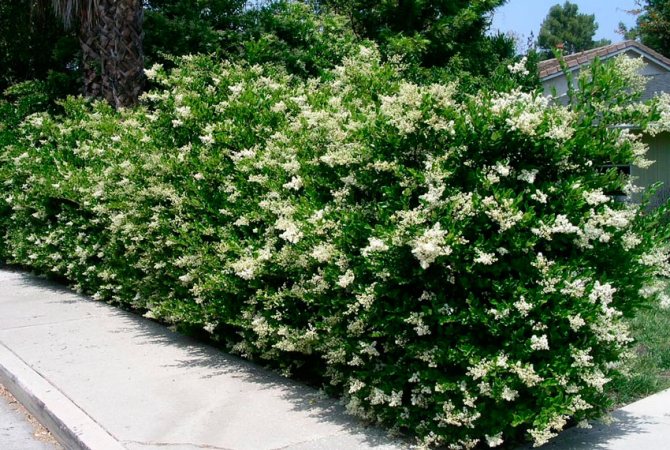

Taking care of privet is very simple. It needs to be watered, cut, loosened on time, while removing weeds. In order to reduce the number of watering and weeding, you can sprinkle the circle with a layer of mulch. However, it is necessary to mulch the soil only after it has warmed up properly. Watering should be done only during a long dry period. If the summer period is moderate, the plants will have enough rainfall. It should be borne in mind that watering should be rare, but abundant enough, since the soil needs to be soaked about half a meter deep. So, one bush should take 3-4 buckets of water. During the growing season, watering on average will need to be done 3 or 4 times.
In spring, it is recommended to feed the plants with organic fertilizers; for this, under each bush you need to add 1 bucket of compost or humus.If this is a hedge, then the organic fertilizer is distributed along the bushes, then granular superphosphate is scattered over it (10 grams of substance per m2). After this, fertilizer must be embedded in the soil at a shallow depth, and then watered.
Pruning privet


Privet is a plant that needs regular formative pruning. Since such a shrub is fast-growing, it will quickly hide all the flaws that were made during pruning. You need to start pruning almost immediately, as the plant is planted in the ground. When the established seedling begins to grow, it will need to slightly shorten the tops of the shoots. As a result, the plant will become more bushy. After the stems have grown by 10-15 centimeters, they will again need to be slightly shortened. This procedure should be carried out regularly during the first two years of the privet's life, as a result the bush will become thick and lush. After the specimen has built up a green mass, formative pruning can be done. Currently, an increasing number of gardeners prefer to cut this shrub in the form of dense cushions (karikomi). This haircut comes from Japan.
In European countries, where the climate is rather mild, privet in hedges can reach a height of 200 centimeters. However, in mid-latitudes, such high bushes can be damaged by frost, therefore, in such areas, the optimum height of privet is about half a meter. In order to avoid frost damage to the shoots in winter, the bushes are covered with a layer of snow. The hedge is trimmed in May and then in August. Sanitary pruning should be carried out in early spring, while injured, frost-bitten, dried and diseased branches should be removed. And those branches that remain must be shortened by 1/3 (if necessary).
Autumn care


In middle latitudes, common privet is most often grown, since this species is resistant to frost. At the same time, the plant can withstand frost down to minus 30 degrees, but only if it is short-lived. In the event that the shrub is covered with a layer of snow, then it will be able to withstand a drop in temperature to minus 40 degrees. The tips of the stems, which have suffered during the winter cold, recover quickly enough in the spring. This type of privet should not be covered for the winter. In other species, for the winter, the trunk circle must be sprinkled with a layer of mulch, the bush itself must be bent to the surface of the soil and fixed in this position. From above, the plant must be covered with spruce branches.
Disease and pests


Privet is highly resistant to various types of diseases. However, if it grows in soil with high acidity, then it may develop powdery mildew or spotting. In this regard, it is necessary to monitor the acidity of the soil. It is very important to timely add a deoxidizer (dolomite flour, crushed limestone or fluff lime) to it.
Spider mites, thrips, worms, aphids and scale insects can settle on this shrub. You can destroy them with Actellik or Fitoverm, and it may take from 1 to 4 treatments with a break of half a month. But if you provide the plant with proper care and optimal growth conditions, then the pests are unlikely to settle on the shrub.
Bush formation rules
Armed with pruning shears or garden shears, you can safely proceed to formative pruning of privet, even if you have never done such a procedure before. The plant quickly forms new shoots, so all pruning flaws will quickly become invisible.
The formation of a bush can begin to be dealt with as soon as the planted young bush begins to grow. To stimulate the growth of lateral branches, it needs to trim the crown off a little. New shoots that have grown by ten to fifteen centimeters are shortened.The shrub grows intensively for two years, so the shoots on young bushes need to be pruned periodically.
Diseases and pests
The shrub has natural immunity and rarely gets sick. However, in acidic soil, powdery mildew and bacterial blotch lurk. To prevent this from happening, you need to deoxidize the soil in time, add dolomite flour, lime.
All affected parts are removed from the diseased plant, sprayed with complex preparations. The treatments are repeated several times. In the spring, the bushes can be sprayed with a solution of whey and iodine to prevent powdery mildew.
Of the pests, thrips, aphids, spider mites, and scale insects bother the bush. For prophylaxis, privet is sprayed with Actellik and Fitoverm preparations. Treatments are carried out 2-3 times with an interval of 14 days.
Reproduction methods
The plant can be propagated by root suckers, cuttings, shoots, cuttings and seeds.
Using layering
Having chosen a low-growing shoot, you need to make a shallow and small incision on it from below. After that, the branch is tilted to the ground and buried in the place of the cut. Be sure to put moss on top and make sure that it is moist all the time. The tip of the shoot should remain at the top. As soon as it begins to grow, the allotted branch can be separated from the mother plant and transplanted to the place chosen for it. This is best done in the spring.
Privet can sprout roots even if not tilted to the ground. To do this, you need to make several scratches on it with a needle. Then this place is wrapped in polyethylene with damp earth. The bag must be secured with tape. Through it it will be seen how the roots appear and grow on the branch. When the root system fills the entire package, the branch needs to be cut from the bottom, remove the polyethylene and plant the shoot with roots on a previously prepared bed.
Dividing the plant by cuttings
At the end of the flowering shrub, ripe shoots are cut off and cuttings about ten centimeters long are cut from them. For them, containers are prepared, at the bottom of which turf is poured, and coarse sand on top. The cuttings are placed in moist soil to a depth of five centimeters at an angle of forty-five degrees.
Rooting should take place at high air humidity and temperatures ranging from +20 to +25 degrees. For better rooting, each cutting is covered with a transparent cap. After about two weeks, the roots will begin to appear. A powerful root system will develop within three months. But bushes are planted in open ground only after a year. During this time, they will grow, and it will be necessary to transplant the plants in a larger container.
An unpretentious and beautiful privet plant is able to decorate the park not only with its foliage and flowering, but also with an interesting crown shape that the gardener can create on his own. From ligustrum, you can create not only a hedge, but also form it in the form of a cone, a ball or dense pillows - karyokami. Cope with such pruning, and every gardener will be able to learn how to shape shrubs.
How to propagate privet (video)
Privet propagates by layering in the spring. To do this, a small incision is made on the strongest branches closer to the ground. The branches bent to the soil are sprinkled with soil and mulched with moistened moss. Subject to the regime of irrigation measures, the layering takes root. The next year, the layers are detached from the parent bush and transplanted to a permanent place.
Privet is a relative of the lilac, which is popular in our country. This ornamental shrub is usually classified as a plant with a narrowly expressed specificity of use, and if we neglect the formation, then the above-ground part will look very ordinary.However, in recent years, there has been a growing trend in the popularity of this culture both among landscape designers and among amateur gardeners.
Hedge
Privet is very popular shrub, used in the organization of hedges. However, in order for privet to be a spectacular decoration of a personal plot, it is necessary to provide proper care for the planting material.
Even before planting a young plant in the selected area, you need to mark the line of the future row. The easiest way to do this is with a rope. For which it needs to be pulled parallel to the dug trench, in which it is planned to plant privet bushes. Plants are planted from each other at a distance of no closer than half a meter. Privet is planted alternately so that the lush part of the plant faces in different directions. After disembarking, you need water the bushes until the water is completely absorbed.
Privet planting technology
- The best time to plant privet in open ground is the beginning of autumn, or rather September-October. Although you can plant this plant in the warm season.
- Having dug up the soil at the chosen place by 15-30 cm, it is necessary to prepare planting holes for the seedlings.
- The pit size for each plant should be much larger than their root system. The pit should be approximately 40 cm deep and 60 cm wide.
- If you plan to plant hedges or curbs on your site, then you need to dig a trench of the same depth and width.
- Before planting, all pits and trenches must be filled with water and wait until it is absorbed.
- Next, a drainage layer must be placed at the bottom of each planting hole to prevent water stagnation at the roots. Fine gravel or expanded clay can be used as drainage.
- Potting soil and humus should be poured onto the drainage layer. Also add 120 g of nitroammophoska.
- Before planting, seedlings must be removed from containers and filled with water. They should stand in a container with water for some time.
- Place the seedlings on the ground in the pits carefully and spread their roots.
- Fill all the holes with soil, tamping lightly with your hands.
- After planting, all the plants need to be watered, and the soil around them should be mulched with dry peat or sawdust.


What do you need to know when boarding?
To begin with, the summer resident needs to decide on the place in which this plant will be planted. Best for privet is a well-lit area. When a landing site is selected near stationary structures, then you need to maintain a distance of 1 m... This way, you won't have a problem when it comes time to prune your plant.
Preparation
If you decide to acquire common privet on your personal plot, then the first thing you need to do is prepare a place for planting. It is imperative to dig the earth to a depth of 25-30 cm, where a hole is made in the future. When determining the size, it must be borne in mind that its depth must be approximately 35 cm more than the root system of the plant.
Before planting, a pit is required watered abundantly... When all the water has been absorbed, the pit is filled with a mixture made from compost and garden soil taken in equal parts. When immersing the bush, it is important that the root system is in its natural state.
Seedling care
Having completed the planting of the plant, the moment comes when the bush care activities begin. Among the priority activities, you need to highlight the first pruning. It is due to this that the shrub receives the necessary crown shape. Privet decorativeness can be achieved by trimming the branch to a third of its size.
The chances of plant survival have increased if the soil is kept moist during the first month after planting.
- when the bush takes root and begins to actively develop, watering is limited;
- in the future it is necessary to carry it out only during a drought;
- it is imperative to cover the root zone with mulch about 2 cm thick.
What are the spots on the leaves?
In the process of growing privet, an ordinary gardener may see greenish or grayish spots on the leaves. This is true a sign of increased soil acidity... The situation can be corrected by adding lime to the soil. To do this, you need to scatter slaked lime on the surface of the soil with a thin layer. Pretty soon, you will notice that there will be no trace of specks on the leaves.
Dolomite flour is an effective means of restoring soil acidity to normal levels. At the same time, with it, the soil is enriched with microelements that privet needs. This fertilizer is quite often used by gardeners, because even after decades it does not lose its qualities and at the same time is inexpensive.
How to choose seedlings?
In order to grow a healthy and attractive plant, you need to start with the right choice of planting material - seedlings.
Before buying the variety that you decide to plant, still consult with a specialist. He will tell you what kind of plant is best suited for your climate. Will you be able to solve the tasks in creating a garden composition or unusual design?
Buy Privet seedlings from nurseries that grow plants.
Inspect the young plant carefully before making a purchase. The seedling should look healthy and free from signs of disease. There should be no creases or defects.
If you are responsible for the choice and purchase of seedlings, you will be able to grow healthy and beautiful plants.
Summary
Few have seen and know the photographs and descriptive characteristics of privet, because the popular name of this shrub is "Wolf berries". But in fact, the bush is an amazingly beautiful plant that can become a decoration of any territory. The shrub is used to create bonsai, in Japan the culture is used to make ikebana. In European countries, on a large number of sites, the shrub is used to form fences and hedges. However, privet is also often found singly. The plant is comfortably clipped, it is fast-growing, unpretentious to care, has immunity to most diseases. That is why privet has only more and more fans over the years.
Poisonous properties
Privet has poisonous properties. More specifically, the harmful substances are found in the leaves and fruits. They can poison both animals and people. In the composition of these parts of the plant there are tetroid glycosides that poison the body when consumed in high dosage.
It is important to remember this for those who have small children. Such decoration of the yard is very dangerous for their lives. Therefore, it is better to refuse growing in the presence of a child.
Despite the toxicity, the culture is used in folk medicine to treat pathologies. But it is important to strictly adhere to the recommended dosages so that therapy does not develop into poisoning.
IMPORTANT! (click to find out)
With intoxication, abdominal pain, general weakness, and loose stools occur. Also, convulsions, impaired coordination of movements are possible, in the worst cases, death.


Fertilizing ligustrum
To reduce the acidity of the soil under the privet bushes, it is useful to add chalk, lime, dolomite flour. Soil deoxidation is carried out with the onset of autumn, embedding lime in the soil. At the same time, it is useful to introduce potash and phosphorus fertilizers, as well as organic matter.


The plant needs feeding 2 times a year.
In summer, complex fertilizers are applied 2 times per season: foliar dressing with mineral fertilizers is carried out on the leaves.Take a look at the photo - timely fertilized privet bushes look very decorative and give good growth.
Preparation steps before planting privet
For a beautiful hedgerow or curb, you need to prepare carefully before planting. It is important to choose a plant variety that suits you and buy a quality seedling, as well as find a place on your site for planting this unpretentious plant.
Stage 1. Selection of privet seedlings
The first and important step in obtaining a beautiful and strong plant is the acquisition of privet seedlings. Before buying, you must definitely decide on a specific variety of privet, because they all differ in frost resistance, the height of the shrub and the color of the foliage. You can consult with a specialist before purchasing to determine the most appropriate variety for your area. To create a hedge, you can purchase higher varieties, but if you plan to plant a live border, then you can pick up a low-growing variety of privet.
It is best to buy privet in specialized nurseries or agricultural firms that are engaged in professional plant breeding. It is important to check the seedling carefully before purchasing. It should be free of damage and signs of disease. The soil in the container must be clean and damp.


Stage 2. Choosing a landing site
Privet grows naturally in the undergrowth, so this plant can thrive in open, sunny places and in light shade. However, to get a beautiful and lush plant, it is best to choose an open place on your site, which is located at some distance from the buildings - about 50-70 cm.It is also important to plant privet at some elevation, since this plant does not like moisture stagnation.
When choosing a location, consider your planned garden composition. To get a hedge, you need to select a place along the edge of the site. To grow a live curb, select a site along the garden paths or areas you want to fence off.
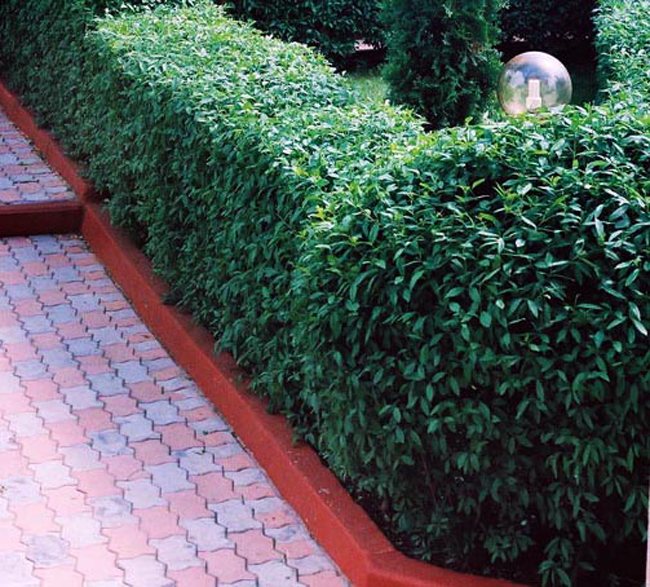

Stage 3. Selection and preparation of soil for planting
Privet is an unpretentious plant that can grow in any soil. However, if you want to get a really beautiful and branchy plant for creating any compositions and shapes, it is important to choose the right soil for this plant. In the place you choose, the soil should be moderately moist, rich in nutrients, and well-drained, since this plant does not like long stagnation of moisture at the roots. The soil should be neutral or slightly alkaline. The ideal potting soil mixture for planting privet can consist of turf, humus and sand in a ratio of 3: 1: 1.
Also, before planting, you need to carefully dig up the soil in the place of your choice on the bayonet of the shovel.

